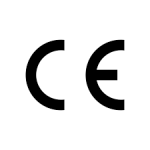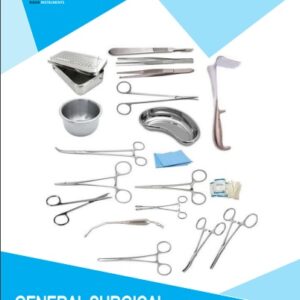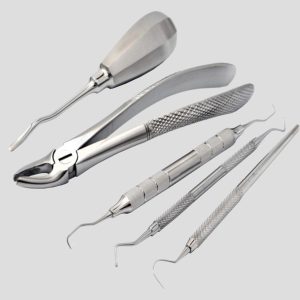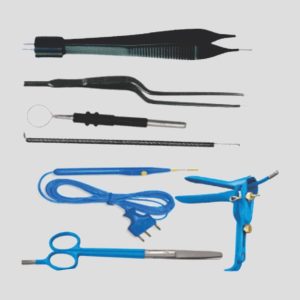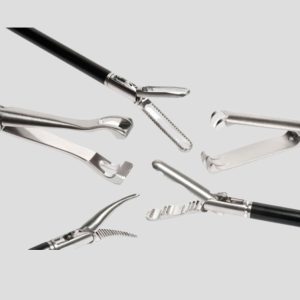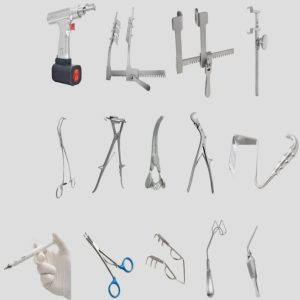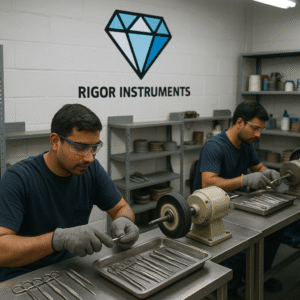
Rigor Instruments is globally renowned for its precision polishing of surgical instruments, a critical step that defines both aesthetic quality and medical-grade finish. With decades of experience and generations of skilled craftsmen, Rigor has become a world leader in polishing techniques.
Why Polishing Matters in Surgical Instruments
Enhances corrosion resistance
Ensures smooth, sterile surfaces
Prevents tissue damage during surgery
Improves grip and handling
Types of Polishing Techniques Used in Pakistan
1. Mirror Polishing
Produces a high-gloss, reflective finish
Common in instruments like scalpels, scissors, and retractors
Achieved through multi-stage buffing with fine abrasives
2. Matte or Satin Polishing
Non-reflective surface preferred in microsurgery and ophthalmic tools
Reduces glare under surgical lights
Achieved using abrasive wheels, sandblasting, or chemical dulling
3. Electropolishing
Electrochemical process that removes micro-debris and sharp points
Results in ultra-clean, smooth surfaces
Increases corrosion resistance and biocompatibility
4. Vibro Polishing (Tumble Polishing)
Used for mass processing of small components
Ensures uniform smoothness on bulk items
Common in dental and orthopedic implants
Rigor’s Competitive Strengths in Polishing
| Factor | Pakistan’s Advantage |
|---|---|
| Skilled Labor | Generations of craftsmen trained in manual and machine polishing |
| In-House Capabilities | Rigor Instruments polish internally |
| Export-Grade Quality | Complies with CE, ISO 13485, and FDA requirements |
| Cost-Effective Production | World-class finish at competitive rates |
| Custom Finishing Options | Matte, mirror, dual-finish, or branded polish available |
Quality Checks During Polishing
Visual inspection under magnification
Surface roughness tested (Ra < 0.4 µm for surgical finish)
Passivation testing (to confirm corrosion resistance post-polish)
Glove test to ensure no sharp burrs remain
Rigor Instruments – Polishing Machinery Lineup
1. Bench Polishing (Buffing) Machines
Type: Single & double spindle
Use: Final high-gloss mirror or matte finish on scissors, forceps, and clamps
Speed Control: Variable-speed motors (1,500–3,000 RPM)
Wheels: Cotton, sisal, felt, and leather buffs
Compatible Abrasives: White, green, or gray polishing compounds
2. Rotary Polishing Tools (Hand Buffers)
Type: Flexible shaft rotary tools (Foredom / Chinese equivalents)
Use: Detailed polishing of tight areas (box joints, serrated tips, finger rings)
Speed: Up to 20,000 RPM
Tools Used: Mounted felt wheels, cones, points, and brushes
3. Vibratory Polishing Machine (Vibro Finisher)
Use: Mass polishing of small parts like dental, ophthalmic, or bone screws
Media: Ceramic, plastic, or stainless polishing chips with compounds
Tank Size: 50–300 L capacity
Cycle Time: 30–120 minutes per batch
4. Belt Grinding & Satin Finishing Machines
Use: Matte or satin finishing on handles and shafts
Belts Used: 180 to 600 grit
Features: Adjustable contact wheels and angle guides
5. Ultrasonic Cleaning Units (Post-Polishing)
Use: Remove polishing compound residue and fine metal dust
Tank Size: 25–100 L
Frequency: 25–40 kHz for deep cleaning of micro-crevices
Cycle Time: 5–20 minutes
6. Dust Extraction & Filtration System
Purpose: Capture polishing dust and metal particles for operator safety
Includes:
Central vacuum hood
Replaceable HEPA filters
Aluminum dust collectors near buffing wheels
Machinery Summary Table
| Machine | Function | Key Feature |
|---|---|---|
| Bench Buffing Machine | Final surface finishing | High-speed with twin spindles |
| Hand Rotary Polisher | Precision polish in joints/rings | Flexible shaft and micro-bits |
| Vibro Polishing Unit | Mass uniform polishing | Uses polishing media and slurry |
| Belt Satin Finisher | Matte/brushed finish creation | Adjustable grits and pressure |
| Ultrasonic Cleaner | Post-polish cleaning | Removes compound & micro-particles |
| Dust Collector System | Safety and cleanliness | HEPA filters and quiet operation |

